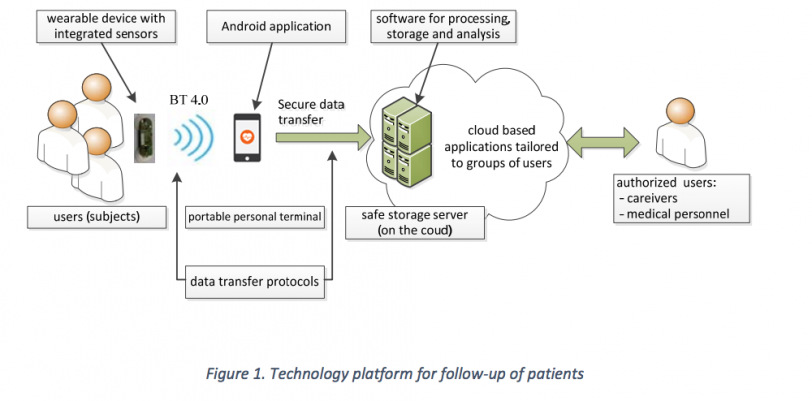Wearable Multifunctional Body Sensor (MedSens)
The motivation for MedSens comes from the lack of widely accepted mHealth solutions, despite the world of ubiquitous mHealth enabling ICT devices. Among the most distinguished medical ICT devices are the wearable wireless sensors that have become advanced enough to provide reliable physiological readings for health management. The key weakness of the implemented approaches is that they mainly focus on the technology, while the importance of its acceptance by users and health care practitioners is largely neglected.
The academic partner of the TTP has developed the technology and software for a multifunctional unobtrusive wireless body sensor (dimensions: 2x9cm, weight: 14 g) with two electrodes at the distance of 8 cm. The sensor has a long autonomy (up to 7 days), a low power wireless connection (BT4) to a Smartphone or other personal device, and a corresponding software for standard interpretation of measurements upgraded with new ambient intelligence approaches. The high‐quality ECG measurements obtained with the sensor are suitable for medical use, either to synthesize a standard 12‐chanell ECG, or in holter‐like investigations for long term monitoring of patients after cardiac surgery and in cardio oncology. The device is complemented with a group of other sensors: space orientation, light, movement, temperature, humidity and barometric pressure, which will allow for ambient intelligence. The ambient data provide the context of the measurements (lying, sitting, walking, falling; night/day). The device can support solutions to every‐day problems of the medical personal in hospitals, health clinics, homes for the elderly and health resorts. Its exceptionally lightweight design allows for unobstructed use also during sports activities or during exhaustive physical work. Currently, there are only a few similar devices, but none has competing services on such advanced level.
The proposed platform for mobile monitoring of patients is schematically shown with the diagram in Figure 1. The core of the system is the small and light body sensor (Figure 2a), fixed to the skin of the user by two standard self‐adhesive electrodes. The charger for the sensor’s battery is implemented as a charging dock (Figure 2b).


The ambition of MedSens is to make the mHealth solution a mainstream for modern healthcare that will be fully supported by medical experts and users, and CE certified. The know‐how is currently protected on the level of industrial innovation and further systematic exploitation of intellectual property rights is carried out in the scope of the present TTP. The expected MedSens outcomes include:
- ergonomically co‐designed and broadly accepted wireless body sensor;
- adopted formal model of the holistic management of health: clinical models, domain & data driven platforms, users' communication interfaces, and personal records with users' health history;
- fully operating pilot systems with more than 100 volunteering test users (healthy citizens and patients) in: the biggest Slovenian hospital and health station, a wellness centre, an AAL centre, and a rehabilitation centre for dystrophic patients.
At the end of the TTP, a certified system as a medical device according to the directive MDD 93/42/EEC, and standards EN 60601 and EN ISO 14971 will be ready, and the system is expected to be near mass production and further industrialization. Start of marketing in planned for May 2016.